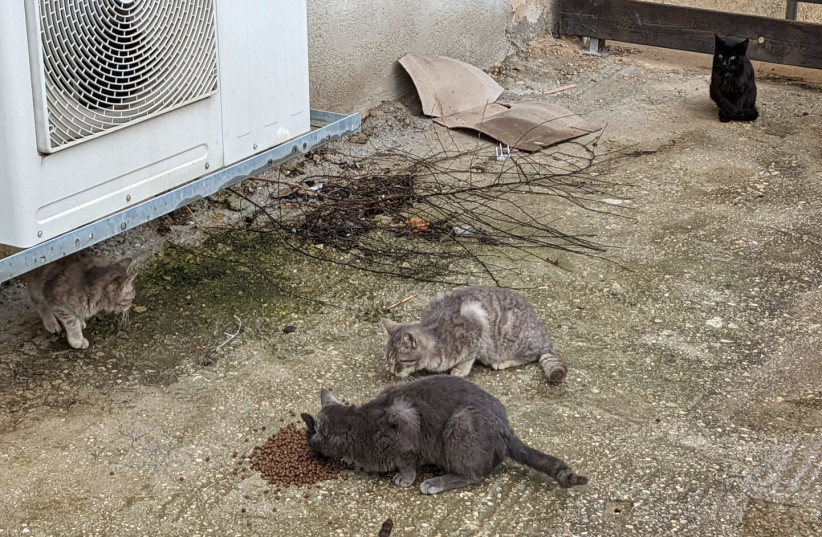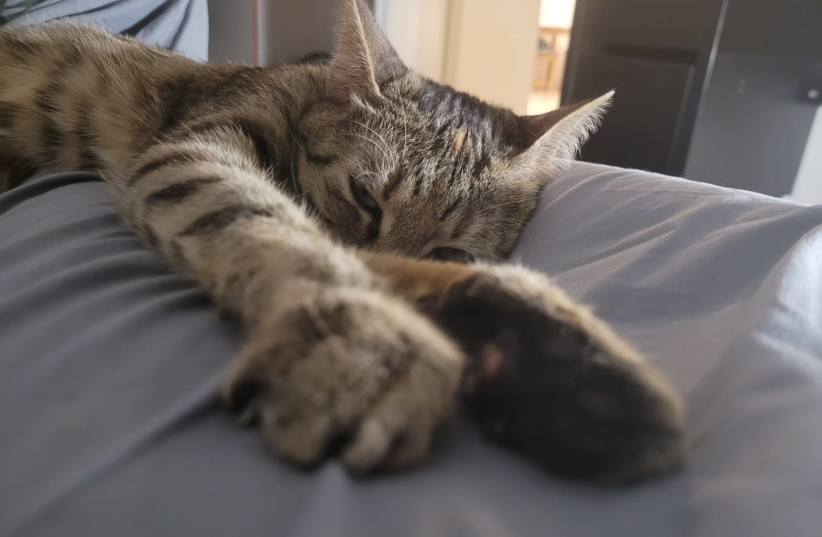Whether stray cats spread diseases to humans is as controversial a topic in social media as whether face masks prevent the spread of COVID-19. It depends whom you ask – physicians and cat haters or humane societies and passionate cat lovers, and there are plenty of the latter.
With an estimated 370 million cat owners in the world, 60 million of them in the US, the worldwide love for cats (and dogs) has been very evident in the scenes of hungry and cold Ukrainian refugees fleeing their country with their pets shielded inside their jackets or in carrying boxes.
Israel has a massive stay cat problem and there are an estimated two million strays in the country, some 240,000 in Jerusalem. According to veterinary authorities, about a third of Israeli home pets (mostly cats) have been rescued from the streets, while some 20% are adopted from animal shelters.
Bowls of water and cat food or meat leftovers are often seen on streets around the country and there are some fanatic ailurophiles (cat lovers) spend hundreds or even thousands of shekels a month leaving food regularly at “cat-feeding stations.”
Some groups maintain that no stray cat survives on the street for more than two or three years, or dies of old age – and that they suffer greatly from cold and hunger. Others claim street cats and live for 12 years or more and don’t look skinny at all.

The American Association of Feline Veterinary Practitioners believes that stray cats are harmful to humans. “Transmission of zoonotic agents from animals to people can potentially occur by direct contact with the animal, indirect contact with secretions or excretions from the animal, and contact with vehicles like water, food or fomites (any inanimate object that, when contaminated with or exposed to infectious agents can transfer disease to a new host) that were contaminated by the animal.
Cats can even become infected with COVID-19 and infect animals that can be spread to people, but this is extremely rare.
The Boston Public Health Association has stated that feral cats “are not common sources of diseases for humans, but they may carry diseases that can make humans sick. Cats’ mouths and claws can contain many harmful bacteria and viruses.
Never provoke a cat to attack you. Do not bother the cat when it is eating, and do not try to move a cat with your unprotected hands. Do not approach kittens, as the mother may be near and is likely to attack you. If a stray cat bites or scratches you, wash the area thoroughly with soap and water right away and see your doctor or nurse immediately.”
This organization says “strays can carry rabies. The rabies virus is in the saliva of a sick animal. Since cats wash themselves by putting saliva on their paws, then grooming their fur, cat scratches as well as cat bites may carry the rabies virus. Anyone who gets a bite or scratch that may have been contaminated with saliva from a wild cat or kitten should see a health care provider about preventive treatment for rabies immediately.”
The association also urges washing hands with soap and water after any contact with cat feces. “Cats carry these diseases that can be passed to humans: salmonella, toxoplasmosis, rabies, ringworm, Q fever, tapeworm, campylobacter, roundworm, cat scratch disease and hookworm.”
But a large-scale study published by the American Veterinary Medical Association found that “rates of common, infectious diseases were similar in pet cats and free-roaming cats. In some cases, pet cats had higher disease rates than free-roaming cats. Because Mother Nature selects the healthiest animals, it is perfectly logical that free-roaming cats are very healthy.”

Whether stray cats pose health hazards to humans or not, researchers at the Hebrew University of Jerusalem (HU) have just published a study on what to do about them. “Increasing numbers of free-roaming street cats is a global problem. In fact, stray cats are considered one of the world’s most invasive species. However, while they pose a health risk to humans, destroy large numbers of wildlife and suffer from poor welfare, most people are reluctant to cull their numbers with the fierceness we bring to rat and cockroach populations.”
The study was led by Prof. Eyal Klement and Dr. Idit Gunther of HU’s Koret School of Veterinary Medicine is the first time that a controlled study has investigated the impact of different protocols over a period of 12 years. Their findings show the importance of implementing a policy of continuously and intensively neutering cats throughout a city, and were published in the PNAS journal under the title “Reduction of free-roaming cat population requires high-intensity neutering in spatial contiguity to mitigate compensatory effects.”
Currently, the most popular population-control method is called TNR in which cats are trapped, neutered and returned to the same location. “Although this method has been implemented in various parts of the world, there was controversial evidence regarding its effectiveness for reducing cat populations and no hard evidence regarding its effectiveness in reducing cat-related nuisances or improving their welfare,” Klement explained.

The study focused on Rishon Lezion and tried out different population–control methods over three four-year periods. In the first, there was no population intervention. In the second, the researchers organized an intensive program of neutering of cats in half of the city’s 50 neighborhoods, while the remaining zones served as a control group in which the cats were left without any intervention. In the third period, neutering was applied to the entire cat population of the city.
The researchers found that neutering in only half of the city neighborhoods failed to cut the cat population; the reason for this unexpected finding, they said, was the “immigration” of unneutered cats into the area. In the third wave, a seven percent annual reduction of the cat population was reached, but a rebound increase in the number of kittens was noted, probably due to an increase in their survival due to lack of competition with the neutered, less aggressive cats.
“Intact cats are more territorial than their neutered counterparts. Once they move into a neighborhood with neutered cats, they tend to thrive and take over,” continued Klement.
According to the study, the ideal method is to ensure that 70% of street cat populations are neutered continuously. To eliminate the rebound effect, Klement suggested that in parallel to the TNR campaign, cat feeding should be controlled.
“This can be achieved by setting up feeding stations in agreed-upon locations and by prohibiting feeding in other public areas,” Klement concluded. “This would ensure cats are properly fed and a policy of neutering could be implemented easily by catching the cats when they come to feed.”
